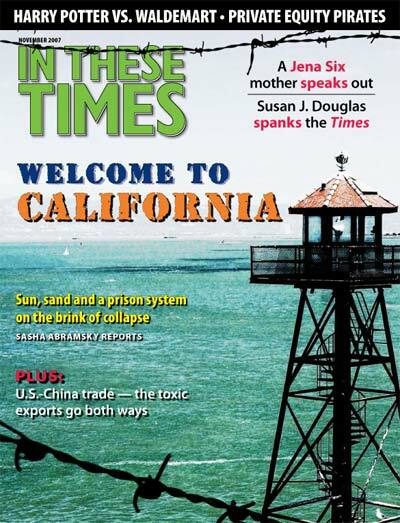E-Wasting Away in China
While the media ride their new lead-painted hobbyhorse--the danger of Chinese wares--spare a thought for Chinese workers dying to dispose of millions of tons of our toxic crap
Terry J. Allen
The highway of poisoned products that runs from China to the United States is not a one-way street. America ships China up to 80 percent of U.S. electronic waste – discarded computers, cell phones, TVs, etc. Last year alone, the United States exported enough e-waste to cover a football field and rise a mile into the sky.
So while the media ride their new lead-painted hobbyhorse – the danger of Chinese wares – spare a thought for Chinese workers dying to dispose of millions of tons of our toxic crap.
Most of the junk ends up in the small port city of Guiyu, a one-industry town four hours from Hong Kong that reeks of acid fumes and burning plastic. Its narrow streets are lined with 5,500 small-scale scavenger enterprises euphemistically called “recyclers.” They employ 80 percent of the town’s families – more than 30,000 people – who recover copper, gold and other valuable materials from 15 million tons of e-waste.
Unmasked and ungloved, Guiyu’s workers dip motherboards into acid baths, shred and grind plastic casings from monitors, and grill components over open coal fires. They expose themselves to brain-damaging, lung-burning, carcinogenic, birth-defect- inducing toxins such as lead, mercury, cadmium and bromated flame retardants (the subject of last month’s column), as well as to dioxin at levels up to 56 times World Health Organization standards. Some 82 percent of children under 6 around Guiyu have lead poisoning.
While workers reap $1 to $3 a day and an early death, the “recycling” industry – in both the United States and China – harvests substantial profits. U.S. exporters not only avoid the cost of environmentally sound disposal at home, but they also turn a buck from selling the waste abroad. After disassembly, one ton of computer scrap yields more gold than 17 tons of gold ore, and circuit boards can be 40 times richer in copper than copper ore. In Guiyu alone, workers extract 5 tons of gold, 1 ton of silver and an estimated $150 million a year.
Many U.S. exporters pose as recyclers rather than dumpers. But a 2005 Government Accountability Office report found that “it is difficult to verify that exported used electronics are actually destined for reuse, or that they are ultimately managed responsibly once they leave U.S. shores.”
This dumping of toxic waste by developed countries onto developing ones is illegal under the Basel Convention, a 1992 international treaty that was ratified by every industrialized nation – except the United States.
Unhindered by international law and unmonitored by Washington, U.S. brokers simply label e-waste “recyclable” and ship it somewhere with lax environmental laws, corrupt officials and desperately poor workers. China has all three. And a packing case with a 100-dollar bill taped to it slips as easily as an eel through Guiyu’s ports.
E-waste fills a neat niche in the U.S.-China trade. America’s insatiable appetite for cheap Chinese goods has created a trade deficit that topped $233 billion last year. While e-waste does little to redress the financial disparity, it helps ensure that the container vessels carrying merchandise to Wal-Mart’s shelves do not return empty to China.
In the 19th century, England faced a similarly massive deficit with China until a different kind of junk – opium – allowed it to complete the lucrative England-India-China trade triangle.
Britain, after destroying India’s indigenous textile industry and impoverishing local weavers, flooded its colony with English textiles carried on English ships. The British East India Company fleet then traveled to China to buy tea, silk and other commodities to sate Europe’s appetites for “exotic” luxuries. But since there was little the Chinese wanted from either India or Europe, the ships traveled light and profitless on the India-China side of the triangle. That is, until England forced Indian peasants to grow opium and, in the process, precipitate mass starvation by diverting cultivable land.
The trade fleet then filled up with opium and pushed it to China through the port of Canton. Since opium was illegal in China, Britain started a war in 1839 to force Peking to accept the drug. By 1905, more than a quarter of China’s male population was addicted.
Now it is Americans who are addicted to Chinese junk. And our own government policies and corporations are the ones stoking the jones. Slick marketing and consumer fetishism push Americans to buy the latest, lightest, biggest, smallest, fastest, trendiest items. And even if you are not hooked on the latest gadgets, repairs or upgrades are impractical. The half billion computers we trashed in the last decade have to go somewhere, and shipping them to China and other poor nations is a win-win solution for Chinese and U.S. industry.
As for the populations of both countries, we can feast on the irony that the same ships that carry toxic toys and food ingredients to Americans return bearing deadly e-waste for the Chinese.









